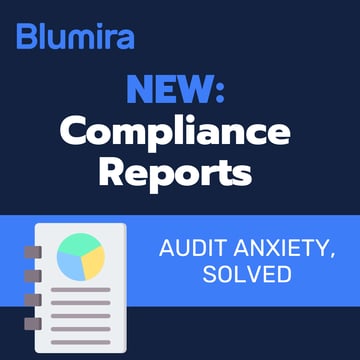- Product
Product Overview
Sophisticated security with unmatched simplicityCloud SIEM
Pre-configured detections across your environmentHoneypots
Deception technology to detect lateral movementEndpoint Visibility
Real-time monitoring with added detection & responseSecurity Reports
Data visualizations, compliance reports, and executive summariesAutomated Response
Detect, prioritize, and neutralize threats around the clockIntegrations
Cloud, on-prem, and open API connectionsXDR Platform
A complete view to identify risk, and things operational
- Pricing
- Why Blumira
Why Blumira
The Security Operations platform IT teams loveWatch A Demo
See Blumira in action and how it builds operational resilienceUse Cases
A unified security solution for every challengePricing
Unlimited data and predictable pricing structureCompany
Our human-centered approach to cybersecurityCompare Blumira
Find out how Blumira stacks up to similar security toolsIntegrations
Cloud, on-prem, and open API connectionsCustomer Stories
Learn how others like you found success with Blumira
- Solutions
- Partners
- Resources
This month, we rolled out Findings page upgrades, making it easier to navigate, review, and take action on findings. Enhancements include the option to resolve findings without completing the workflow, linked MITRE ATT&CK® codes, and one-click copying of finding short IDs. Detection filters are now more flexible, with the ability to create and edit filters directly from Detection Rules. We added two new Windows detections, including one addressing the recent SharePoint vulnerability, and improved detection accuracy across Azure, Linux, VMware, and FortiGate. We also fixed key bugs and introduced enhancements to the Blumira API, MSP Portal, and Findings List Page for a smoother user experience.
Feature and Platform UpdatesDetection Filters on Detection Rules: Now you can create and edit your detection filters directly in Detection Rules before a finding is generated, even when a rule is disabled! No more waiting for findings to appear before you start tuning out the noise; customizing detections with allowlists now starts as soon as onboarding.
Findings Detail Page Upgrades:
-
Improved Information Layout: Users can easily locate basic information for the finding.
-
Improved Navigation: Users can now navigate to their dashboard or go to the previous or next open findings from the Findings details page, enabling easier and faster access to the findings that still need attention.
-
MITRE ATT&CK Codes: Users can see which ATT&CK codes each finding is associated with and follow links to the associated ATT&CK knowledge base entries to learn more about the techniques and related tactics.
-
Resolve a Finding Individually: Users can now immediately resolve a finding directly from its details page without needing to complete the workflow and without using the bulk select feature on the Findings table.
-
Copy Finding Short ID: This new option enables users to easily copy the finding’s short ID, which is useful when it is needed in searches or pasting into an email or ticketing system.
Detection Updates
| Log Type | Details |
|---|---|
| Windows | NEW - 20+ Failed Windows Login Events for Non-Existent User in 60 Minutes This detection identifies when over 20 failed Windows login attempts occur within an hour associated with non-existent users. This activity may be suspicious or could also surface stale service accounts no longer in use. Threat actors often use long lists of random usernames in an attempt to guess a username/password combo. Default state: Disabled |
| Windows |
NEW - CVE-2025-49704 SharePoint Suspicious Web Shell File Created in LAYOUTS Directory This detection was created in response to the recent vulnerability affecting on-premises SharePoint servers. Legitimate web shells should not be running out of this directory and any related finding should be thoroughly investigated. Default state: Enabled |
| Azure_signin | UPDATE - Azure: Entra ID Anomalous Agent Sign-In Activity Detection logic updated to add O365 Diagnostic Service to general exclusions. |
| Azure_signin | UPDATE - Azure Identity Protection Risky Sign-in Users can now review the action_details field in the evidence of the finding to understand why a sign-in was blocked or allowed. |
| Fortigate_event | UPDATE - Fortigate: Successful Admin Login from External IP Address Detection logic updated to account for instances where src_ip is null. It now uses IP address in message field as a back up. The message field has also been added to evidence. |
| Osquery | UPDATE - Linux Reverse Shell The parent.cmdline field has been added to several detections which may reveal a script name or some other details that will make investigation and filter building much easier. |
| Vmware_vcenter | UPDATE - VMware: VM Deletion Detection logic updated to exclude failed VM removal logs. Updated logic will now only match on successful VM deletion. |
| Windows | UPDATE - Local User Addition or Modification via Net Commands The parent.cmdline field has been added to several detections which may reveal a script name or other details that will make investigation and Filter building much easier. |
| Windows | UPDATE - Mimikatz Process Creation or Command Run A false positive workflow option has been added at the first step to provide a quick workflow option to indicate when a finding is benign. |
| Windows | UPDATE - Nltest Domain Enumeration The parent.cmdline field has been added to several detections which may reveal a script name or other details that will make investigation and Filter building much easier. |
| Windows | UPDATE - Outlook .pst File Export Detection logic updated to exclude false positives generated by .pst exports from internet calendar subscriptions. |
| Windows | UPDATE - Signed Binary Proxy Execution: Msiexec The event_type field has been added to help investigate and provide appropriate context of the alert. |
Bug Fixes and Improvements
Bug Fixes
-
Detection Filter Duplication: Fixed an issue where Detection Filters were being duplicated immediately after saving.
-
Sub-Account Access: We resolved a bug that could cause an MSP administrator to lose access to a sub-account.
Improvements
-
Detection Filter Fields: Filters can now be created using any field present in evidence. Previously, detection filters couldn’t be created if a field was in an unsupported type in our database. This would cause those fields to not populate when attempting to create those filters.
-
MSP Portal: Administrators can no longer deselect themselves from the Users page in the MSP Portal, which means they must ask another administrator in their organization to remove them from an account or reach out to Blumira Support.
-
API Enhancements:
-
Findings /comments results now include author details to identify who added a comment on the finding.
-
The MSP Findings endpoint now includes assignee, notes, and note authors.
-
Added filtering options to the Findings endpoints, including:
"blocked", "category", "created", "created_by", "created_after", "created_before", "modified", "modified_by", "name", "org_id", "owners", "priority", "resolution", "seconds_to_status", "status", "status_modified_by", "type"
-
-
Findings Table: The table now retains filters when users navigate to and from the page.
-
Tags Page: The Tags page has been deprecated.
June 2025 Release Notes
In case you missed the June updates, you can find and review those notes here.
Tag(s):
Product Updates
Eric Pitt
Eric is a Product Marketing Manager at Blumira focusing on customer research and positioning to continuously improve the Blumira platform.
More from the blog
View All Posts
Product Updates
14 min read
| September 10, 2025
August 2025 Product Releases
Read More
Product Updates
11 min read
| August 5, 2025
July 2025 Product Releases
Read More
Compliance Security Frameworks and Insurance
7 min read
| July 17, 2025
Blumira's Compliance Reports: Making Audit Assessments a Breeze
Read MoreSubscribe to email updates
Stay up-to-date on what's happening at this blog and get additional content about the benefits of subscribing.